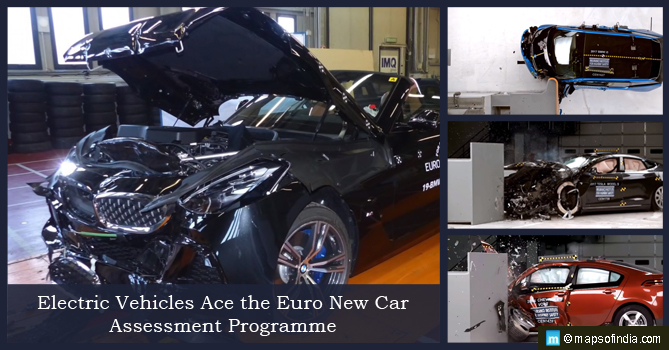
The Euro NCAP (New Car Assessment Programme) conducted its latest round of safety – crash tests and seven cars including the Mercedes Benz EQC and Skoda Kamiq got full marks.
Other new cars to receive the maximum score of five star safety rating were the Ssangyong Korando, the BMW Z4, the Audi A1 sportback and the Mercedes Benz CLA. All these electric production models matched numbers with their rivals Jaguar I-pace and Audi – e tron.
The Korando is a fourth generation car by Korean car maker Ssangyong, and the first model by the company to achieve a five star rating all thanks to the automatic emergency braking system, now a standard equipment for enhanced safety.
The Ford Focus – also one of the cars to achieve full marks, though not a new model, has managed to retain its 5 star rating by making some minor changes to the model.
The BMW Z4’s active bonnet, which lifts up automatically in case of a pedestrian impact was enough to impress the Euro NCAP. The Mercedes CLA scored above ninety percent in three key areas out of four in the safety test to claim the top rating.
The Kamiq is the smallest SUV by the Czech automaker Skoda and it was able to score a full 5 star safety rating due to its various safety systems.
The vehicle scored ninety six percent in adult occupant protection and eighty five percent for child passengers. It achieved eighty percent for the safety of vulnerable road users like pedestrians and cyclists, and for the SUV’s driver assist functions’ effectiveness, seventy six percent.
The number of safety features in the Kamiq helped it in achieving the highest rating. The Euro NCAP in its assessment of the vehicle stated that Kamiq’s compartment remained stable and protection of all critical areas of the body was up to the mark in each of the various tests it was put through.
The safety system in Kamiq includes the basic features like front and side airbags, seat belt reminder and load limiter along with pretensioner. Other than these systems it also has autonomous emergency braking (AEB), speed assistance and lane assist system. All these features are standard for all the variants in the SUV’s line up in Europe.
Mercedes Benz EQC and Skoda Kamiq are a topic of interest for the Indian market as Benz is likely to launch EQC, its first all electric SUV in India very soon, and the Skoda Kamiq might get an SUV based on it for our market, under Volkswagen group’s “India 2.0” project. However the Indian spec of Kamiq will be based on the MQB-AO-IN platform, which means it won’t have all the safety features generally included by Czech automakers.
Euro NCAP Secretary General Michiel Van Ratigen assured that though the number of cars securing five star rating might make it seem like an easy task, to meet the test requirements for technology is very demanding. And they always need to be upgraded to incorporate the latest technological developments.
The Euro NCAP is going to change their rating requirements again next year but the results they have gotten assure that all the manufacturers are keen on maintaining these high standards.
Electric vehicles are becoming increasingly popular in India, and with the government going the extra mile to promote them, they are looking at a bright and positive future in the country. Electric vehicles are eco friendly and cost efficient because of lower fuel costs and maintenance expenses. EV’s are the future and to convert to them is the logical step, and the centre’s various schemes along with reduced taxes have made many manufacturers keen to come up with them in our market.
Until recently the only all electric car available for Indian customers was the Mahindra eVerito but now we can expect a plethora of them very soon. The ones that are already here or will be here in a few months are Audi e tron, BMW i8 roadster, Ford Aspire EV, Mahindra KUV100, Jaguar I – pace, Maruti Suzuki Wagon R EV, MG eZS, Nissan Leaf, Renault City K-ZE, Tata Altroz EV, Volvo XC60. Hyundai recently launched its first EV in the country – the Kona electric – which is priced at rupees twenty five lakh and thirty thousand.
The only barrier in this seamless transition between the ICE (internal combustion engine) and electric vehicles is the small number of charging stations in the country for the all electric cars. States like Delhi, Mumbai and Hyderabad are leading the charge for making their cities ready to embrace this new future of the automotive industry. Hopefully, with the government on board with this new age technology, the whole country will slowly but gradually make the transition to electric vehicles.
Related Links:
Forthcoming Electric Vehicles in India




